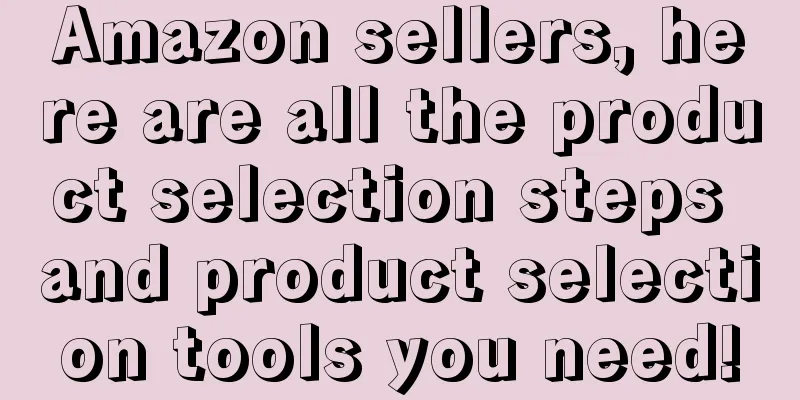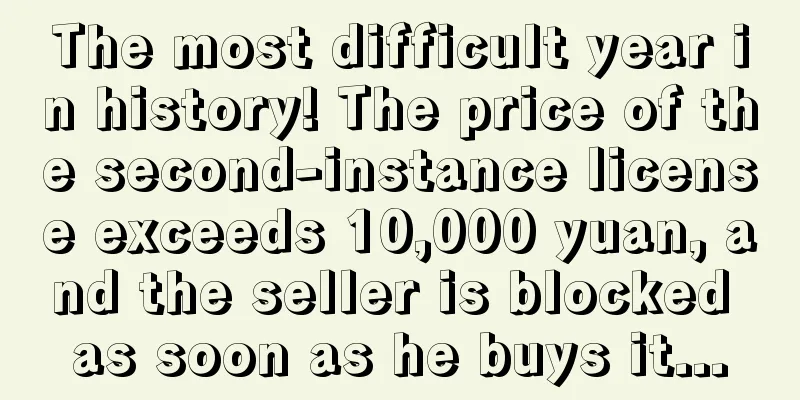Amazon sellers, here are all the product selection steps and product selection tools you need!

|
So how should sellers choose products? In fact, it only takes two steps: According to eMarketer, apparel and accessories sales account for the largest market share (19.7%) in the e-commerce industry, followed by computers and consumer electronics at 14.8%. But this does not mean that sellers can just open a clothing online store and sit back and count money. Within a large category, sellers can provide many subdivided niche products. The benefits of selling niche products include: 1) less competition, which helps to gain market share; 2) helps to increase profits; 3) can obtain users with greater stickiness; 4) reduce advertising expenses. Sellers can find profitable niche industries and products from the following aspects: 1. Check out the areas you are interested in; 2. Identify your target audience. 3. Determine whether you can add value to the product; 4. Research industry trends; 5. Research the feasibility of the product; 6. Look at the margins and possible profits of each potential niche product; 7. Research possible competitors. Here are a few ways: First, sellers need to check current users and understand their current pain points so as to launch new products that can solve these pain points. Let’s say you’ve opened an online clothing store that sells printed T-shirts in three main categories: women’s, men’s, and kids’. Smaller subcategories of the latter include “kids baseball tees” or “kids long sleeves.” However, you can go even deeper into a theme to make your product even more unique and creative. A good example is The Mountain’s dinosaur T-shirts: You can also find niche products within a niche market by:
When sellers select products on e-commerce platforms, they can start with trending products that they are interested in or products that can solve their own pain points. When choosing products, you can ask yourself how to make your product stand out from the crowd of similar products. E-commerce company GearBunch does this well by combining popular leggings with holidays such as Halloween: Get a sense of what products are trending at any given time by looking at data from Amazon, eBay, Google Search, Google Trends, AliExpress, Alibaba, Kickstarter, and comparison shopping sites. You can also see the most popular search terms for that category by using each platform’s search query box, which populates with suggested keywords. Alternatively, sellers can use the dropshipping platform Oberlo, which highlights products based on user product reviews, product page views, and product orders (in the past 30 days and the past 6 months). Trending products are good, but what sellers can do is to either make trending products more unique, or to seize product trends as early as possible before competition becomes fierce and reap the benefits first. Sellers can find product trends through the following methods:
Finally, no matter how popular a product may seem, make sure it fits your business infrastructure and has room to grow. When choosing a product, sellers can ask themselves a few questions:
Recommend 7 e-commerce tools to help sellers select products: With Commerce Inspector, sellers can analyze competitor sales, find popular products, discover new competitors and search products from over 300,000 e-commerce stores. Think with Google offers a range of tools that allow sellers to research trends, analyze competitors, and view industry standards and consumer insights. It is a great product selection tool because it contains data on brands and products in the niche market. Jungle Scout offers a Chrome extension that allows sellers to view valuable product data while browsing Amazon. Even if you don’t sell on Amazon but use Amazon to research new trending products, this data can help you ensure you’re getting all the relevant information. Dropship Spy gives sellers access to daily updated best-selling product lists, users can choose specific product suggestions for their niche, and the Facebook Audience Builder tool. They now also offer a tool for finding and measuring Instagram influencers. Subscription plans start at $15 per month. Pexda is an online platform that helps sellers find products in their niche based on Facebook ad impressions. eComhunt is a manually curated product listings site that showcases trending products. The product data listed on eComhunt includes the following for each product: profit, analytics, exposure, links, Facebook ads, product video, Facebook targeting, and offer type. It has free and pro versions. Social Mention is a free online search tool that helps sellers find keywords that buyers are searching for. In addition to the keywords and sub-keywords that people are talking about on social occasions, it also provides popular hashtags, which sellers can then search to see products posted by other sellers. If you still feel that the above 7 tools are not enough, you can click "Read original text" to view more product selection analysis tools: Text✎ Fang Xiaoling/ Statement: When reprinting this article, the title and original text must not be modified, and the source and original link must be retained. |
Recommend
The epidemic has caused a surge in sales of such products, but sellers...
On January 13, Pacific Time, the Los Angeles Times...
What is Crunchbase? Crunchbase Review
Crunchbase, founded in San Francisco, USA in 2007,...
Three categories that Amazon must not touch!
1. Categories that need to be reviewed Some catego...
What is Tanga? Tanga Review
Tanga is a well-known e-commerce platform in the U...
What is POCO? POCO Review
POCO is China's leading and fashionable photo ...
Impact of Trump's tariff plan: Prices of goods from China and other three countries will rise by up to 56%
It is learned that recently, according to foreign ...
Amazon advertising placement tips: Are you still mindlessly raising the CPC to a high percentage to get on the homepage? Why do other people’s rankings rise so fast for the same keywords?
laohai My C position How to make accurate use of e...
What is sender? sender review
Sender is a UK-based email marketing tool. Nature ...
Limited to 2,000 copies | "Global Cross-border E-commerce Resource Manual" officially released
"We aim to effectively link cross-border sell...
What is STARDAY? STARDAY Review
STARDAY is a cross-border e-commerce service platf...
Amazon's "palmprint payment system" has caused concern among US senators, who were asked to provide relevant security information!
It is learned that Amazon's recently launched ...
What is Xiwen e-commerce? Xiwen e-commerce review
Xiwen E-commerce (Zhuhai) Co., Ltd. is an e-commer...
Amazon banned your product for variant violation? Let’s find out more about variants!
There are more and more cases of sellers having th...
Watch out! Amazon 2025 will also have very strict restrictions on brand names!
Some sellers have recently reported that in addit...
Amazon Review Practice- VINE VOICES Green Label
<span data-shimo-docs="[[20,"一、什么是亚马逊Vine ...









